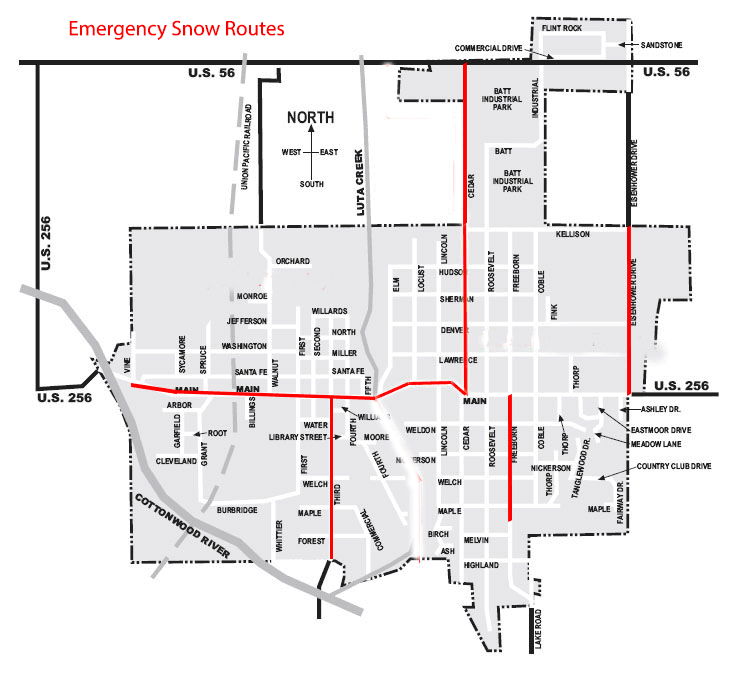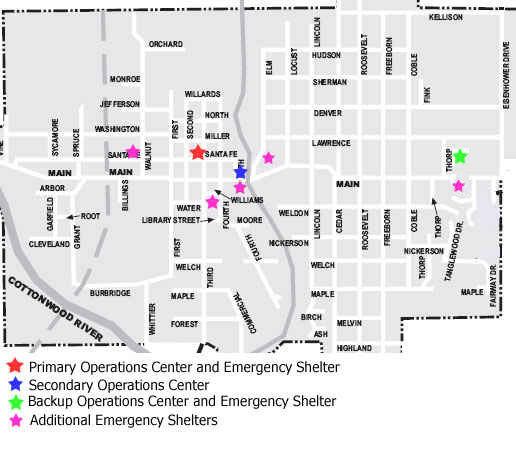Disaster Procedures
Emergency Maps

Emergency Operations Center
I. Purpose
The City of Marion is National Incident Management Compliant (NIMS) and has adopted and will utilize the NIMS. Incident Command is designated as the Chief of Police with the City Administrator as Alternate Incident Command.
Purpose
If a disaster strikes this city, an Emergency Operations Center (EOC) is the key to a successful disaster response operation. The Executive Heads of government are responsible for their respective cities and the county. With decision making heads together at one location, manpower and resources can be utilized more effectively. Coordination of activities will ensure that all tasks are accomplished without duplication or conflict of effort.
Location
The location of the primary EOC is the Marion City Building.
In the event of a flood disaster, the primary EOC and the secondary EOC is located in the flood plain and are not feasible for use. The Eastmoor United Methodist Church will be designated as the primary EOC, in this instance as it is not located in the flood plain.
EOC Activation
If a disaster strikes this city, the Mayor shall have the authority to order partial or full activation of the city disaster EOC. In absence of the Mayor, the succession of command shall be as follows: (1) Vice Mayor (2) City Administrator (3) Police Chief (4) Asst. Police Chief. Upon learning or having reason to believe a disaster has occurred within the city, officials shall report to the City Disaster EOC as soon as possible to activate and or assist in EOC activation.
EOC Staff and Staff Responsibilities
Due to space limitations, as well as limited city employees, only the following officials or functional groups will operate from the city disaster EOC. All other key personnel will operate from their normal work locations.
They are as follows:
- Mayor
- City Clerk
- Assistant City Clerk
- Chief of Police
- City Administrator
- Director of Public Works
- Fire Chief
- Electric Department Supervisor
Note:
It is anticipated that the Chief of Police, Fire Chief, Director of Public Works and Electrical Department Supervisor may have to be at the disaster scene during the initial disaster response operations.
The City Officials should make every effort to keep City Elected officials and Department Heads informed of the disaster scene activities for the most efficient management of resources. Additional communication radios will be commandeered from the Chingawassa Committee resources to ensure maximum communications is possible.
STANDARD OPERATING PROCEDURE FOR FLOOD NOTIFICATION FOR THE CITY OF MARION
The flood levee that surrounds the valley of Marion prevents flooding from the Cottonwood River, Mud Creek and Clear Creek. Engineering reports state that the old Cottonwood River channel and bar pits inside of the levee will hold enough water produced by 12 inches of rain with no release. Over 12 inches of rain could result in predicted minor flooding of the valley. In this case, arrangements could be made to pump excess water over the dike and evacuate residents is necessary. The personnel listed in this Disaster Plan would arrange the evacuation.
Upon receipt of an impending major flood for the City of Marion, the Marion County Sheriff’s Office dispatcher shall notify the Marion Police Department Duty Officer of the impending major flood. He or She will then make the proper notifications by calling out the necessary City Emergency Personnel. These personnel will at that time proceed to further disseminate the warning. Emergency vehicle units (Police or Fire if needed) will utilize sirens and public address systems to alert citizens of the warning.
Police Department responsibility will be broken down as such:
Marion Police Department units or Fire Department units will be responsible for alerting citizens and residents of the Valley area starting from Elm Street to the western city limits.
Special emphasis for notification in the Valley is:
Marion County Courthouse, Law Enforcement Center, and Extension Office.
Bown-Corby School and Santa Fe Apartments
V.F.W. Post, Senior Citizens Center, Library, and Valley Methodist Church.
Any other community building where people may be congregated.
The Marion Police Department Duty Officer is in charge of the situation until relieved by a supervisor and it will be his responsibility to obtain available assistance from off duty officers and the City Mayor as well as obtain needed vehicles and equipment.
While under an impending major flood, City Emergency Service Personnel will operate on the Marion City Fire Radio frequency due to the projected increase in radio traffic on the Marion County Sheriff’s frequency. By utilizing the city frequency, all city personnel involved will be able to maintain a line of communications with the Marion County Sheriff’s Department Dispatcher through the Marion Police Department Officer stationed at the Police Department as well as all other city emergency vehicles in use.
If the Marion County Sheriff’s Department Dispatcher receives a report of flood damage anywhere in the City of Marion the dispatcher will notify the Command Post at the Eastmoor United Methodist Church. The officer stationed at the Command Post will in turn notify the Marion City Mayor, David Mayfield, City Administrator Roger Holter and the County Emergency Preparedness Director, Randy Frank.
The Emergency Preparedness Director will then activate the Marion County Emergency Operations Plan if needed.
Evacuation of residents:
Residents who are in the flood plain area will be evacuated by emergency personnel to what is commonly referred to as the Hill area.
The flood levee is not designed to protect the city if there is a break in the Marion Dam or a mal-function at the control gates caused my man or nature. If this were the case, there would not be enough time for any reasonable warning or an evacuation. It is estimated that the entire valley and possibly some upper elevations of Marion would become flooded. The odds of this scenario are considered to be minimal. Every effort and resource would be utilized to keep residents of Marion safe.
SHELTERS UTILIZED FOR POWER OUTAGES
Following is the Emergency Response Plan for utilization of shelters during power outages:
- Shelters will be designated as primary and secondary, depending on the type of emergency involved and shelters available.
- Shelters will be manned by city and or volunteer personnel at all times.
- Persons utilizing shelters will be logged in and out.
- Forms will be provided for this purpose.
- Forms will include name, address and phone number of persons with date and time.
Primary Shelter Designated:
- The Primary Shelter will be designated as Marion Community Center. 203 N. 3rd Street.
- This shelter will be primary due to generator in case of loss of power.
- Capacity of the Primary Shelter is 750.
- Cooking facilities are available.
- Persons manning shelter will make arrangements for food for citizens utilizing shelter through the City Administrator or City Clerk.
Secondary Shelters Designated:
- Secondary shelters will be designated by the City Administrator or City Clerk.
- The Marion Sports & Aquatic Center. 104 N. Thorp. Total Capacity 2,000
- The Ministerial Alliance Churches will be utilized as Secondary Shelters as deemed necessary by the City Administrator or City Clerk. They are as follows:
- Eastmoor Church, 105 Eastmoor Drive. Total Capacity: 500
- Emmanuel Baptist Church, 229 Walnut Street. Tot. Cap: 500
- Christian Church, 140 N. Elm. Total Capacity: 500
PLAN FOR COMMUNICATIONS IN THE EVENT OF AN EMERGENCY
Below is listed the emergency warning signals for the City of Marion. Please seek immediate cover when you hear the sirens sound and stay there until the all-clear signal is given.
- TORNADO or other disaster: One continuous five-minute siren blast
- ALL-CLEAR: One-minute siren blast
- FLOOD EVACUATION: No Siren will be sounded. Police cars will be dispatched to warn citizens over their car PA systems to proceed to a flood evacuation area.
- The emergency sirens are tested every Monday at noon to make sure they are in working order. If the weather looks bad the city will not sound the sirens as to not cause a panic.
For more information on tornado safety or up to the minute radar imagery, please visit the National Weather Service @ http://www.weather.gov/

